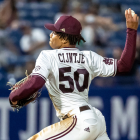
The Detroit Tigers fired general manager Al Avila last week, ending a seven-year tenure that produced one winning season and zero playoff appearances. To be fair, Avila oversaw a rebuild for most of his reign. He likely hoped to mimic the Cubs and the Astros, two clubs who suffered upfront as a vehicle to later lift a trophy, but he couldn't figure out the exact recipe that lifted those franchises from the bottom to the top.
He tried to add his own Jon Lester or Justin Verlander and jumpstart the Tigers' competitive cycle last offseason, signing free-agent left-hander Eduardo Rodríguez and shortstop Javier Báez to lucrative long-term contracts. Those moves have failed to achieve the desired effect in Year 1; instead, the Tigers are on schedule to extend their playoff drought to eight years by winning fewer than 40 percent of their games for the fifth time in six tries. To make matters worse, perceived foundational pieces and former No. 1 picks Spencer Torkelson and Casey Mize have had disappointing seasons. Torkelson because of his play, Mize because of injury.
The next Tigers general manager will have their paws full correcting Avila's mistakes and trying to get the franchise back on track. Those won't be the only challenges that come with the job, either. They'll also have to deal with an accomplished manager who has more stroke than his peers; an owner who is trying to escape the shadow of his late father (and his wallet); and a fan base that has grown weary after years of rudderless rebuilding. Other than that, it's a golden opportunity for whichever enterprising executive gets their name put on the big office's door.
Below, CBS Sports has provided a deeper dive on the Tigers organization (and the headaches that await) by breaking down Detroit's big-league roster, farm system, and budget, as well as addressing three major questions about the situation.
Big-league outlook
It's not a pretty situation. The Tigers have shown little ability to develop hitters or to help their starting pitchers miss bats. To wit, they have 14 players with at least 100 plate appearances: only one of them (Harold Castro) has an OPS+ above 100; they also have had 11 pitchers start at least five times, and none of them averaged so much as a strikeout per inning (though Tarik Skubal came close, at 8.9).
These Tigers have been so thwarted by underperformance and injury that it's difficult to find exceptions. Skubal, Mize, and rookie starter Beau Brieske are on the shelf because of arm woes; Torkelson and fellow top prospect Riley Greene have scuffled; multi-year veteran additions like Rodriguez, Báez, and Austin Meadows (acquired this spring in exchange for Isaac Paredes) have failed to hit their benchmarks; and so on. Rodriguez, Báez, and Meadows have enough of a track record to expect some kind of positive regression heading forward -- or, at least, that's the optimistic conclusion.
The Tigers' youngsters don't have the benefit of the past working in their favor, but they do have the hopes of the future riding on their backs. If they're good, there's a pathway here for Detroit to become a competitive team; if they're not, there aren't enough reinforcements coming to make up for it. That's why it's concerning that Torkelson was one of the worst-performing players in the majors prior to his demotion. He hasn't hit much better since heading to the minors, accumulating a .664 OPS in 93 plate appearances. The offensive bar for right-right first basemen is so high that he'll have to really, really hit heading forward to stand out from the crowd.
On the flip side, Greene's topline statistics may not be good, but his underlying indicators suggest he'll be fine, as he's hitting the ball hard and minding the zone. Skubal is the breakout star on the pitching staff. Mize had a fine season in 2021, though his injury history ought to raise concern about his long-term viability as a starter. Brieske and former top prospect Matt Manning have performed like adequate starters overall; your mileage may vary on their chances of keeping it up. There are some interesting young players here, in other words, but they offer few certainties.
The kindest way to assess the rest of the Tigers roster is to write that, should the incoming GM desire to win right away, they'll likely have to add at least three or four new starters to the lineup ahead of next Opening Day -- and that ignores that the pitching staff will need some attention as well. Again, it's not the best situation on paper, and it's easy to understand how they've failed to contend.

CBS Sports HQ Newsletter
Your Ultimate Guide to Every Day in Sports
We bring sports news that matters to your inbox, to help you stay informed and get a winning edge.
Thanks for signing up!
Keep an eye on your inbox.
Sorry!
There was an error processing your subscription.
Farm system outlook
Considering the Tigers haven't made the playoffs since 2014, it would be reasonable to expect their farm system to be brimming with blue-chip talent as a product of selecting high in the draft each summer. It's not. The Tigers have graduated several notable names in recent years -- including Torkelson, Mize, Skubal, and Greene -- and those departures have tipped the scales. What was once a top-heavy system is now a below-average one that lacks a surefire top-50 prospect.
The Tigers didn't help themselves in the summer of 2021, when they used the No. 3 pick on prep right-hander Jackson Jobe. History suggests that drafting a high-school right-hander with a top-10 pick is asking for trouble; the Tigers nevertheless felt he was a good bet. Jobe was supposed to combine top-notch stuff with surprising polish, but the early returns have been dismal. He's still young and there's no sense dismissing him or his chances of having a solid career; still, it's reasonable to suggest the Tigers must already regret passing on Boston Red Sox shortstop Marcelo Mayer.
Comparatively, the Tigers played it safe with their top picks this summer, choosing a pair of collegiate infielders with their only top-100 selections. Second baseman Jace Jung isn't much of a defender and he may have to slide further down the positional spectrum in due time. Jung can really hit and he should move quickly, even if scouts question how much of his plus power will play in-game. Shortstop Peyton Graham has a handful of average or better tools, and his boosters within the industry still think his best days are ahead. It's up to the Tigers' development staff to prove them correct.
The Tigers do have a few other names worth keeping in mind. Infielder Colt Keith is out for the season with an arm injury, but he had hit for average and power at High-A despite being several years younger than the average competition. Catcher Dillon Dingler is a good athlete with above-average power; his tendency to strike out will limit his ceiling. The Tigers have dropped nearly $3 million apiece to sign shortstop Cristian Santana and outfielder Roberto Campos. Both remain years away, with Santana looking like the better prospect at this point in time.
Budget outlook
The Tigers' Opening Day payroll checked in at $135 million, the highest since 2017. That figure is buoyed by the veteran trio of Miguel Cabrera, Rodríguez, and Báez, who were supposed to combine to make $66 million this season. (Rodríguez's stay on the restricted list because of a personal matter has changed the math.)
Those three will continue to eat up Detroit's budget for the foreseeable future unless Chris Ilitch opens up his wallet, the way his father Mike did repeatedly when the Tigers were on the cusp of a championship. Cabrera, who recently confirmed he'll return for the final guaranteed season of his contract, will bank $32 million next year. He'll then be owed $8 million in the two following seasons if the Tigers have to buy out his options. (If he retires, they'll be free of those buyouts.) Meanwhile, Rodríguez and Báez will take home more than $35 million combined through the 2026 season.
It's worth noting that the Tigers were running payrolls north of $150 million throughout the past decade, and that they should be able to scale up more if they desire. In other words, don't blame the players; blame the owner if they cry broke.
Three big questions
1. Rebuild again, or build upon?
The first question the next GM will have to answer is whether or not there's enough potential here to push forward, or if the best route forward is embarking on another rebuild. Should the answer be the latter, then the Tigers could look to move left-hander Tarik Skubal this winter. Teams who inquired on Skubal at the deadline felt the Tigers over-asked, a common gripe throughout Avila's tenure. That Skubal is now out for the season with arm trouble is a development far too reminiscent of how the Michael Fulmer and Matt Boyd situations played out, with injuries ultimately robbing them of trade value and the Tigers of hearty packages of prospects.
2. How much input will Hinch have?
The belief in the industry is that Hinch has more sway than the normal field manager, to the extent that he oversaw the organization's improved analytical infrastructure. The next GM might not welcome what they perceive to be Hinch overstepping, setting up a potential power struggle with a manager who 1) they didn't hire and 2) is under contract through the 2025 season. It wouldn't appear that Hinch is going anywhere anytime soon, and that could impact who takes a real interest in the job.
3. Will Ilitch spend?
As noted in the budget section, the Tigers have no excuse to keep their payroll below $150 million based on their past spending. That doesn't mean the junior Ilitch will see things the way his father did, however, and he may be reluctant to throw more of his family's fortune at what he perceives as a lost cause. Ilitch's financial comfort level will go a long way in dictating what path the Tigers take in the near future.


















